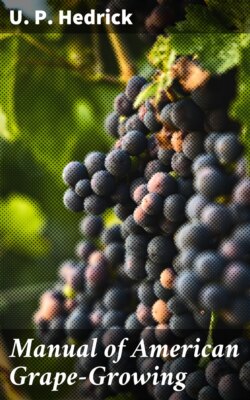Читать книгу Manual of American Grape-Growing - U. P. Hedrick - Страница 64
На сайте Литреса книга снята с продажи.
Tongue grafting.
Оглавление"When the stocks and scions are prepared and graded the grafter takes a box of stocks and a box of the corresponding size of scions and unites them. Each is cut at the same angle in such a way that when placed together the cut surface of one exactly fits and covers the whole of the cut surface of the other. The length of cut surface should be from three to four times the diameter of the cutting, the shorter cut for the larger sizes and the longer for the thinner. This will correspond to an angle of from 14.5 to 19.5 degrees. The cut should be made with a sliding movement of the knife. This will make the cut more easily and more smoothly.
"The cut should be made with a single quick motion of the knife. If the first cut is not satisfactory, a completely new one should be made. There should be no paring of the cut, as this will make an irregular or wavy surface and prevent the cuttings coming together closely in all parts.
"The tongues are made with a slow, sliding motion of the knife. They are commenced slightly above one-third of the distance from the sharp end of the bevel and cut down until the tongue is just a trifle more than one-third the length of the cut surface. The tongue should be cut, not split. The knife should not follow the grain of the wood, but should be slanted in such a way that the tongue will be about one-half as thick as it would be if made by splitting. Before withdrawing the knife it is bent over in order to open out the tongue. This very much facilitates the placing together of stock and scion.
"The stock and scion are now placed together and, if everything has been done properly, there will be no cut surface visible and the extremity of neither stock nor scion will project over the cut surface of the other. It is much better that the points should not quite reach the bottom of the cut surface than that they should overlap, as the union will be more complete and the scions will be less liable to throw out roots. If the points do overlap, the overlapping portion should be cut off, as in the Champin grafts.
"A skillful grafter, by following the above-described method, will make grafts most of which will hold together very firmly. Many of them would be displaced, however, in subsequent operations, so that it is necessary to tie them. This is done with raffia or waxed string. The only object of the tying is to keep the stock and scion together until they unite by the growth of their own tissues, so that the less material used the better, provided this object is attained. For the formation of healing tissue air is necessary, so that clay, wax, tinfoil or anything that would exclude the air should not be used. The tying material is passed twice around the point of the scion to hold it down firmly, and then with one or two wide spirals it is carried to the point of the stock, which is fastened firmly with two more turns and the end of the string passed under the last turn. The less string is used the more easily it is removed later in the nursery.
"Untreated raffia should be used for late grafts which are to be planted directly out in the nursery, but if the grafts are to be placed first in a callusing bed it is best to bluestone the raffia in order to prevent rotting before the grafts are planted. This is done by steeping the bundles of raffia in a three per cent solution of bluestone for a few hours and then hanging them up to dry. Before using, the raffia should be washed quickly in a stream of water in order to remove the bluestone which has crystallized on the outside and which might corrode the graft.
"Some grafters prefer waxed string for grafting. The string should be strong enough to hold the graft, but thin enough to be broken by hand. No. 18 knitting cotton is a good size. It is waxed by soaking the balls in melted grafting wax for several hours. The string will absorb the wax, and may then be placed on one side until needed. A good wax for this purpose is made by melting together one part of tallow, two parts of beeswax, and three parts of rosin."
